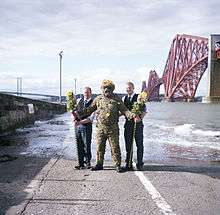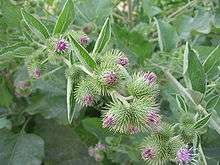The Burryman
The Burryman or Burry Man is the central figure in an annual ceremony or ritual, the Burryman's Parade, that takes place in the South Queensferry area of Edinburgh, on the south bank of the Firth of Forth in Scotland, on the second Friday of August. The custom is associated with, but separate from, the town's Ferry Fair.[1] The meaning of this ceremony has long been forgotten, but it has been the cause of much speculation.[2] It is sometimes said that the custom was first recorded in 1687 (when the right to hold the Ferry Fair was originally granted[3]), but it is widely believed to be much older.[1][4]

The ceremony

According to folklorist Christina Hole, writing in 1976, the day of the Burryman ceremony (the second Friday of August) is the day before the town's Ferry Fair.[1] but the present Ferry Fair website[5] suggests that it comes at the end of a week-long fair.
On the Friday morning, a local man is covered from head to ankles in burrs (the sticky flowerheads or seedheads of two species of burdock, Arctium lappa and A. minus)[4] that grow locally. The stickiness of his burry covering means that he has to walk awkwardly, with legs apart and arms held out sideways, but he is nevertheless paraded around a seven-mile route through South Queensferry for nine hours or more.[6] He supports his aching arms on waist-high poles decorated with flowers. Two attendants (dressed in normal clothing[1]) guide him through the town and help him through his ordeal. The Burryman starts at the Staghead Hotel where is dressed in the burrs.[7] The first stop is the former Provosts house at Villa Road then he parades round the town including visits to every public house, at each of which the Burryman is given a drink of whisky, but because of his sticky facial covering he can only drink through a straw. Local residents also give drinks of whisky so by the end of the day he is exhausted.[4]
Tradition holds that he will bring good luck to the town if they give him whisky and money, and that bad luck will result if the custom is discontinued.[1]
Only men born in the village can take on the role of the Burryman. The office is commonly held by the same person for a number of years. Alan Reid was the Burryman for 25 years (until 1999); his successor, John Nichol, took over until 2011.[4] Other past holders of the position have included John "Jacko" Hart, Sam Corson, Arne Fredricksen and Judith McPhillips (the Wee Burry Man, 1948). Since 2012, the position has been held by Andrew Taylor.
In 2005, the Burry Man inspired an avant-garde folk song by Daniel Patrick Quinn, narrated by local man Duncan Grahl.[8]
The Burry Man is also featured in the 2007 period crime novel The Burry Man's Day by Catriona McPherson.
Details of the costume
The Burryman is meant to collect his covering of burrs for himself, as well as any ferns and flowers used to decorate his costume and the two flower-covered staves (poles) that he rests his hands on.[4] John Nichol admits to recruiting his family to help gather the large number of burrs: approximately 11,000 are needed. They are then meshed together into about 25 flat panels (A3 in size), like natural Velcro, which can be wrapped around his body on the morning of the ceremony. The process takes about half an hour.[9] He dresses in several layers of clothing to protect himself from their hooks. A balaclava covers his head and face; it too is covered with burrs, leaving only small eye and mouth holes;[9] a flower-covered bowler hat tops off the outfit.[2][10]
He wears boots (his feet are the only parts of his body to remain uncovered by burrs) and has a broad sash around his waist, currently made from a folded Royal Standard of Scotland,[2] displaying the top half of a red lion rampant on a bright yellow background.[10] The choice of flag used in the outfit has varied, as a photograph from the 1970s shows the sash around the waist made from a folded Union Flag.[11] However, more recently no flag has been worn as the Burryman himself wanted a more traditional look as flags round the waist was a fairly new idea[12]
Suggested origins
There are many theories about the origin of the custom, what the ceremony means, and why it continues. One idea is that the parade was intended to ward off evil spirits - it can certainly ward off children, some of whom are terrified at the very sight of the Burryman, and avoid looking him in the eye.[4] It has been suggested that he carries on a tradition thousands of years old; that he is a symbol of rebirth, regeneration and fertility (similar to the Green Man) that pre-dates almost all contemporary religions; that he is a "scapegoat"[1] and may even originally have been a sacrificial victim.[4]
Similar ceremonies used to be held in other Scottish fishing communities, notably Buckie on the Moray Firth and Fraserburgh, to 'raise the herring' when there had been a poor fishing season.[1][4] Now, only the South Queensferry ceremony remains in Scotland, though there are possible parallels with the Whittlesea Straw Bear[1] and the Castleton Garland King (and perhaps even the Jack in the green) in England, as well as other customs elsewhere in Europe.
See also
References
- Hole, Christina (1978). A Dictionary of British Folk Customs, pp53–54, Paladin Granada, ISBN 0-586-08293-X
- The Burryman: article at Scotsman.com (accessed 21 September 2009)
- The 1687 Proclamation of the Ferry Fair Archived 20 September 2009 at the Wayback Machine
- Flora Celtica
- Ferry Fair website
- 2007 Burryman route Archived 4 May 2009 at the Wayback Machine
- Local knowledge
- "The Burryman featuring Duncan Grahl": (accessed 25 July 2014)
- Queensferry's Burryman Archived 2 May 2009 at the Wayback Machine John Nicol's online article
- Gallery of Burryman 2009 photos (accessed 21 September 2009) Archived 20 April 2013 at Archive.today
- Extract from book by WW Fyfe Archived 28 August 2011 at the Wayback Machine
- local knowledge from a resident and follower
External links
- John Nicol on being the Burry Man